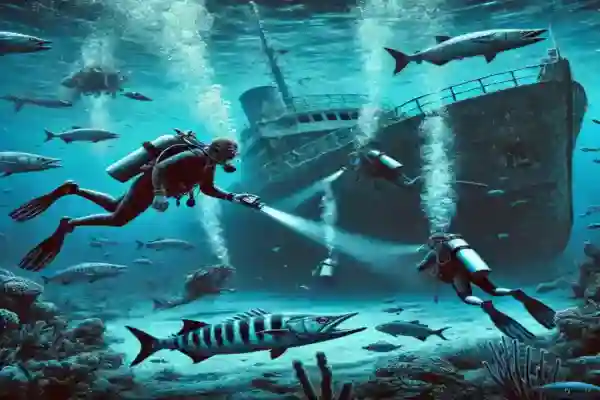Deep Diving – What is it, and What Are the Risks?
Deep diving officially starts at 18.1 meters for recreational divers and extends to the maximum sport diving limit of 40 meters. Anything beyond that falls into the category of technical diving. But why do divers go deeper? What are the risks? And what should you know about decompression and dive sequence planning? Here’s everything you need to know about deep diving!
1. Deep Diving for Recreational and Technical Divers
Deep Diving for Recreational Divers
For recreational divers, deep diving starts at 18.1 meters and is limited to 40 meters. To dive deeper safely, you should take a Deep Diver course, which teaches you the necessary skills and safety procedures. While many countries don’t legally require a Deep Diver certification, diving beyond your training level is never a good idea.
Deep Diving for Technical Divers
Technical diving goes beyond the 40m limit and includes:
- **Decompression dives** with extended stops
- **Specialized equipment** such as twin sets, sidemount configurations, or closed-circuit rebreathers (CCR)
- **Gas mixtures** such as Nitrox, Trimix, or Helitrox for different depths
2. Why Go Deep? What’s There to See?
Many wonder why divers go deep when colors fade and visibility decreases. But there are many great reasons:
- **Wrecks** – Many sunken ships and airplanes lie in deeper waters.
- **Large marine life** – Sharks, mantas, and large schools of fish are often found in deeper zones.
- **Caves & Reefs** – Deeper reef sections offer spectacular formations and marine life.
However, light decreases with depth, causing colors to fade. Modern dive lights and red filters help restore the natural beauty of the underwater world.
3. Why Are No-Decompression Limits and Decompression Calculations Important?
Past vs. Present
In the past, divers relied on fixed decompression tables. Today, **modern dive computers** dynamically calculate decompression needs in real-time. However, understanding decompression models and proper dive planning remains essential for safe diving.
4. What Certification Do You Need to Dive to 40m?
By default, the **Open Water Diver** certification allows diving up to **18 meters**. To dive up to **30 meters**, you need the **Advanced Open Water Diver (AOWD)** certification. For safe diving at the sport diving limit of **40 meters**, the **Deep Diver** course is required.
While many countries do not legally mandate Deep Diver certifications, diving to 40m immediately after an OWD course is not recommended. Advanced courses teach specific procedures for planning and conducting deep dives safely.
5. The Most Important Rule in Deep Diving: Dive Sequence
Always remember:
The
deepest dive of the day should be your first dive.
This simple rule significantly reduces the risk of decompression
sickness (DCS).
✅ Example of a Safe Dive Plan
- Dive 1: 40m – deepest dive first
- Dive 2: 25m
- Dive 3: 15m – ends with shallow dive
⚠️ Dangerous Dive Sequence (To Avoid)
- Dive 1: 12m
- Dive 2: 30m – too deep, too late
- Dive 3: 14m
💡 Why It Matters
- Starting with shallow dives allows nitrogen to build up early.
- Going deeper afterwards increases the risk of DCS dramatically.
Essential for deep diving: Understanding your gas consumption is critical for safe deep dive planning. At 40m, you consume 5x more air than at the surface! Learn how to calculate your SAC rate
📊 Study Insight: Decompression Risk from Dive Order
A 2004 study by Divers Alert Network (DAN) analyzed over 1,000 dive accidents and found:
- Divers who started with the deepest dive had a 47% lower DCS risk.
- Incorrect dive order caused DCS-like symptoms (e.g., dizziness, joint pain) in 33% of cases.
- Divers going from 12–15m directly to 30m+ had up to a 60% higher risk.
- Ending with shallow dives improved nitrogen off-gassing by 15–30%.
🛡️ Recommended: Diving Insurance
For peace of mind, we strongly recommend having dive accident insurance before your trip. Accidents are rare – but when they happen, coverage matters.
✅ Final Tips
- The deeper the dive, the longer nitrogen elimination takes.
- Incorrect dive sequences can raise your DCS risk by up to 60%.
- Best practice: Always start deep and finish shallow!
Final Thoughts – Enjoy Deep Diving Safely!
Deep diving opens up new possibilities but also increases risks. If you want to dive deep safely, you should:
- ✅ Complete **proper training** (AOWD, Deep Diver)
- ✅ **Understand dive computers & tables**
- ✅ **Follow the correct dive sequence**
- ✅ Be aware of **decompression & nitrogen loading**
➡ Want to explore the depths safely? Sign up for our Deep Diver course now!


